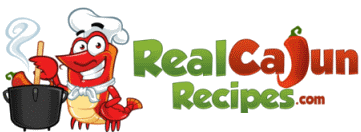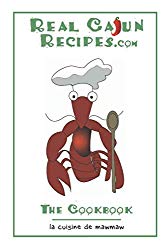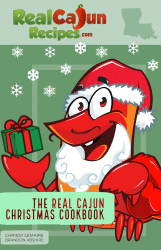Ah C'est Bon
What most people say about Cajun cuisine
Andouille
Cajun sausage made from pork meat, pork stomach and seasonings. Used for flavoring gumbos, jambalayas, beans and other dishes.
Beignet
A deep fried doughnut that almost every Cajun child grew up eating and made popular worldwide at the Caf
Bisque
A popular thick stew, roux based, usually made with crawfish. The carcass carapace of the crawfish is stuffed with the meat of the tails, seasonings and bread crumbs.
Boucherie
Before freezers and large refrigeration, families or group of neighbors would get together to butcher the fatted calf or pig and divide the various cuts of meat among the participants. If it was a pig being slaughtered Cajun dishes such as boudoin, hogshead cheese and cracklings were usually made.
Boudin or Boudoin
Light brown in color, one of the more popular Cajun sausages is made with rice and pork meat. Eating cracklings with boudoin was almost a must or with cush cush and syrup.
Bouille
A pudding dish made with flour, water and milk. Used as a dessert or a treat when you were sick. Spelled also, Bouillie, it is another term for cane syrup pie.
Bouilli
A dish made with pork heart and liver. Cajuns never throw anything away, even pig feet get pickled.
Boulet
A Cajun meatball made with anything from ground beef, shrimp or garfish. Usually has various seasonings and a small amount of flour for flavor and browning.
Bourre
To cut small pockets in various meats such as a roast, chicken or wild game and stuff the slotted pockets with a seasoning mix of onion, garlic, vinegar, salt, red pepper and black pepper.
Café Brulot
Several upscale New Orleans restaurants now serve an adaptation of the Café Noir coffee (see below) adding flavorings and Cognac.
Café Noir
The Cajun's version of Espresso coffee. Strongly flavored drip black coffee that usually made your hair stand on end. That is why it was served in very small coffee cups. The coffee was made in the small granite white drip pots and never boiled. The water had to be boiling before pouring it very slowly over the coffee grinds. Whenever the compaigne (company) came, the oldest child or lady of the house served the coffee, cream and sugar on a serving platter going from one guest to the other with the oldest, usually the MawMaw, served first.
Cajun Microwave
Always inventive, this wooden charcoal heated box was used to cook meat outdoors.
Cajun Music
French music where Cajuns dance the waltz, two step and jitterbug. The band consists of an accordion, guitar, drummer and the ever popular scrub board. Steel guitars were added later along with Zydeco style music.
Cochon de lait
Translate to a "pig of milk" representing the suckling pig that was roasted for special occasions such as weddings.
Cornichon
A vinegar type of pickle that is canned in a glass jar and made with either cucumbers or mirlitons (vegetable pears or chayote squash) and usually contains hot peppers. These are eaten with gumbos or rice and gravy. The vinegar juice is used by many Cajuns to flavor gumbo (as if it needs it).
Coulee
A body of water that can be free flowing or a pond in the backyard. Coulees often have small fish, crawfish and snakes. Some coulee's waters are rain filled only.
Courtbouillion
A tomato based fish soup usually made with catfish or redfish. Some Cajun cooks added a small amount of roux to this dish.
Crab Traps
Cotton netting attached to a triangle of wires and baited with spleen or chicken necks to fish/catch crabs.
Cracklins
These were generally made at the Boucherie by deep fat frying the pork skin that had fat and meat attached. The cracklins were then flavored with a mixture of salt and peppers. Some people call pork rinds cracklins. Cracklins go really well with boudoin.
Crawfish
A small red crustacean that resembles a lobster and is the base of many famous and delicious Cajun dishes.
Crawfish Cage
A wire meshed cage baited where crawfish can crawl into the cage but cannot get out without the help of the crawfish farmer.
Cush Cush/Couche Couche
A cereal made with cornmeal and water. This dish was a staple food for many Cajuns. Served with milk, fig preserves were commonly served or fresh cracklins.
Debris
A dish made combing the leftover parts of the animal such as the liver, spleen, intestines and the like with lots of onions. It has a delicate flavor and is served over rice
Duck Blind
The stationery hunting spot where hunters could be "blind" to the ducks. You always had the faithful dog that would swim the waters to retrieve the fallen ducks.
Duck Calling
The noise made to lure ducks near the blind on hunting trips. It was said if you could "call the duck" you had good Cajun blood running in your veins.
Easter
A religious holiday ending the Lenten season. Cajuns celebrate by having a crawfish boil or fish fry.
Etouffee/ Etouffe/ Etoufee
No matter how you spell it, this is probably one of the more popular Cajun dishes made with a blend of spices using crawfish or shrimp. It is creamy and served over rice. The term etoufee means "smother" or "cook down". This dish does not use any roux.
File'
Ground sassafras leaves used to season gumbo. It was added to the gumbo right at the end of the cooking process; either directly in the pot or in the plate.
Fricassee
A thick Cajun stew made with roux and any type meat. If you were using pork this stew would also have potatoes in it. Chicken is probably the most popular meat used.
Frog Hunting
Always hungry for great food, a Cajun dons a bright light in the dark and using a stick or gun catches frogs for the next day's meal or to sell to neighbors or local restaurants. The carcass and head of the frog after being skinned is used to make sauce piquant and the frog legs are generally fried. The skin can be dried over two empty cans and connected with a long string, making a telephone for the younger children.
Fruite de Mer
Fruits of the sea referred to oysters, crabs, shrimp, fish or anything else fished from the waters. Also refers to a plate of food with a combination of seafood.
Gateau de sirop
This word translates to Syrup Cake, a moist cake made with cane syrup.
Green Onions
One of the more popular Cajun herbs. Green onions are most commonly called onion tops by the Cajuns.
Guinea Hen
This noisy spotted grey bird made the best gumbo you could ever eat. The guinea has dark and very flavorful meat. This hen was raised by many households many years ago. Sadly you do not see many guineas any more.
Gumbo
Called a "brown soup", gumbos are roux based and are made with just about any meat you can find. Meats such as duck, chicken, blackbirds, pork or deer sausage, tasso, Andouille sausage or seafood can be used singly or in any combination.
Lagniappe
A little something extra that is free. In the older days, you would get a piece of glassware when you purchased oatmeal.
Lent
A religious holiday, beginning with Ash Wednesday, the day after Mari Gras and continues for 40 days, would have Cajuns doing penance and not eating meat on Fridays. Instead they ate seafood. As another penance there was not any dancing during the Lenten season.
Mardi Gras
Fat Tuesday - The celebration with food, beads and parade to signify the approaching leaner times. "Throw me something Mister" are the most used words that day.
Mirlitons
Commonly called a vegetable pear or chayote squash, it was used to make pickles for gumbos and rice and gravy or eating right out of the jar.
Okra
A vegetable with green pods that originated from Africa that can be used to make gumbo or smothered down as a side dish. . Gumbo is also the Cajun French word for okra.
Oreilles De Cochon
(Pigs Ear) A special treat in Cajun land is a crisp, sugary and light pastry. So called a pig's ear because once it is dropped into deep hot fat, and you give a swift twist to the center with a long handled fork as soon as it hits the grease, the pastry forms the shape that looks like a pig's ear.
Pain Perdu (Lost Bread)
The dish flavored with egg and milk used bread that had gone stale and would have been lost if not used for this dish or bread pudding.
Pirogue
A small wooden boat used in the marsh, bayou or swamp for fishing or getting to the duck blind. If it was filled with beer there was a wedding going on. It is usually rowed or poled through shallow water.
Poisson
Cajun word for Fish. Popular eaten fish included as catfish, redfish, and garfish.
Pralines
The most popular Cajun candy made when the pecans and the beginning of winter started. Pralines were also made popular at the French Market in New Orleans.
Reintier
The cut of meat on a pig referring to the backbone. One of the best cuts that can either be roasted or deep fat fried.
Roux
The most classic Cajun creation made by cooking flour and oil together. The popular phrase, "First you make a roux" is used to create dishes such as gumbo, fricassee stews, courtbouillion, and sauce piquant, even spaghetti sauce and other dishes.
Salt Meat
As the name implies, salty pork used to flavor beans and greens.
Sauce
Gravy made by deglazing (adding a little bit of water) the drippings of the meat. The gravy is usually served over rice.
Sauce Piquant
A hot spicy stew made with tomato paste or sauce, roux and most any meat available. The most popular is turtle or alligator sauce piquant.
Sausage Casing
A natural casing usually made of pork or beef intestines used in preparing boudoin and sausages. Casings are sold by the hank. With a hank of casings, you can generally stuff 100 pounds of sausage.
Smothered
The process of "cooking down" food is where the volume is reduced to a smaller portion.
Tasso
A dried smoked piece of pork used to give flavor to different dishes. Slice the tasso real thin and place between two slices of fresh bread, a little mustard and you have a great meal.
Visite'
An afternoon visit spent with family or friends passing around the coffee, the news and the latest stories..
Zydeco
A type of music enjoyed by the Cajuns that lends itself to a new style of dancing. Zydeco music had its origin in Africa.








